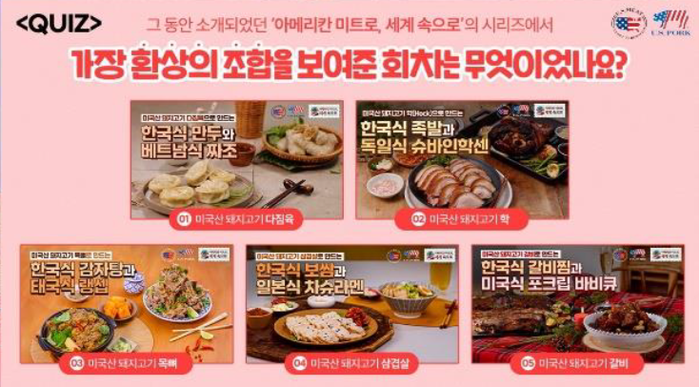Versatility, convenience drive Korean consumers’ demand for U.S. pork
Series featured several inexpensive, underutilized pork items such as pigs’ feet, hocks and neck bones.
March 13, 2024
.jpg?width=850&auto=webp&quality=95&format=jpg&disable=upscale)
U.S. pork exports to South Korea closed last year with excellent momentum and this trend has continued in early 2024. December exports to Korea were the largest in more than four years at just under 24,000 metric tons, up 64% year-over-year, while export value soared 69% to $82 million – the third highest on record. These results pushed 2023 exports 9% above the previous year at 191,262 mt, the third largest on record, while export value was the second highest on record at $633.4 million (up 4%).
January data from USDA, as compiled by the U.S. Meat Export Federation, showed more positive news as exports to Korea soared 53% from a year ago to 20,727 mt. Export value was up 51% to $67.6 million.
The U.S. industry is achieving this growth at a time when the Korean pork market is exceptionally competitive. Domestic pork production is at a very high level and last year Korea imported larger volumes of Canadian, Mexican and Brazilian pork. This was due in part to tariff rate quotas that gave some imports from these countries duty-free access – a status normally enjoyed only by U.S., European and Chilean pork under their respective free trade agreements.
But the U.S. recaptured substantial market share from the European Union, as EU exports to Korea fell 14% to 243,000 mt. With the exception of 2020, this was the lowest volume of EU pork entering Korea in the past 10 years. The U.S. share of Korea’s imported pork market jumped from 26% in 2022 to 32% in 2023, and edged even higher (34%) in January 2024.
Highlighting the versatility of U.S. pork is a major USMEF marketing objective in Korea. With funding provided by the National Pork Board and the USDA Market Access Program, USMEF recently targeted younger Korean audiences with an original content series on YouTube called World Wide Meat. The five-episode series, which showcased U.S. pork for use in traditional dishes from different countries, garnered 873,000 views.
The series was developed with an eye on the rebound in international travel in Korea, especially among younger generations such as Millennials and Gen Z. Media consumption behaviors of the two demographics was also considered as USMEF produced long and short-form content from the series for distribution through YouTube and Instagram.
“International travel is picking up in Korea and there is growing interest in learning about other cultures, especially new foods,” says USMEF Korea Director Junil Park. “Meanwhile, food prices remain high in Korea so we developed original content programming around affordable U.S. pork cuts and created cultural learning opportunities in each episode.”

USMEF. World Wide Meat, a five-episode video series on YouTube that showcased U.S. pork, generated 873,000 views. Viewers were also invited to identify their favorite episode for a chance to win pork barbecue meal kits.
The series featured several inexpensive, underutilized pork items such as pigs’ feet, hocks and neck bones. Each episode demonstrated how a particular U.S. pork cut would be utilized in a traditional Korean dish compared to a traditional dish from a different country. To leverage additional engagement at the end of each episode, viewers were offered opportunities to win prizes by answering questions about the featured pork cuts.
Convenience is also a driving force behind U.S. pork’s growth in Korea, where restaurant traffic has recovered at a slower-than-expected pace but consumers have sought other avenues for enjoying high-quality meals. Korea has been a global leader in development of home meal replacement options that satisfy consumers’ desire for convenient dining options, especially for those in one and two-person households. According to Euromonitor, single-person households now account for 35% of Korea’s total households and two-person households account for 28%.
“Korean people really love to try new foods but they are very pinched for time,” explained Jihae Yang, USMEF vice president for the Asia-Pacific region “About 10 to 15 years ago, some key distributors began to develop HMR products on a very small scale and the sector has achieved tremendous growth. In addition to convenience, HMR products are also very cost-effective compared to cooking from scratch, especially for smaller households. In this respect, U.S. pork offers a very affordable and versatile ingredient option for HMR companies.”
Korean retailers continue to face intense competition from e-commerce, so they are remodeling stores and focusing on the fresh food category, while also keeping HMR front and center. This focus on fresh convenience is beneficial to U.S. pork, as a widening array of U.S. cuts are being merchandized through HMR. For example, army stew features sausages and other processed pork products, while pork bulgogi often includes Boston butt. In contrast to the United States, Korea’s pork consumption is mainly fresh but there are further opportunities for processed products such as bacon and ham.
About the Author(s)
You May Also Like



